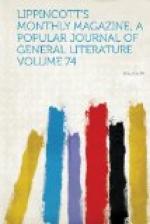The present castle stands on the spur of an adjacent hill, and commands the same extensive prospect. Though of moderate size (too small, indeed, to accommodate at the same time the king and the queen-mother with their respective suites, for which reason it is occupied by each only during the absence of the other), the appearance of the castle is imposing, and its interior decorations render it a most interesting point for the tourist, as well as a delightful residence for its proprietors. The walls of all the principal apartments are adorned with frescoes painted by some of the best German artists, each room being devoted to a special subject. There is the “Hall of the Swan-Knight,” containing illustrations of that most charming legend, the foundation of the world’s best opera, Lohengrin; the “Schwangau Chamber,” with pictures concerning the history of the locality; the “Bertha Chamber,” containing the story of the parents of Charlemagne; the “Ladies’ Chamber,” portraying the life of German women in the Middle Ages, the principal figure being a portrait of Agnes, wife of Otto von Wittelsbach, an ancestor of the royal house; the “Hall of Heroes,” containing illustrations of the Vilkina Saga, Dietrich of Berne being supposed to have lived at Hohenschwangau; the “Knights’ Chamber,” representing the knightly customs of the Middle Ages; the “Oriental Chamber,” with frescoes recalling King Maximilian’s travels in the East; and several other rooms, in each of which is commemorated some striking point of German history or some interesting record of national manners. The furniture of all these apartments is rich and tasteful; and scattered here and there are little indications of home-life which lend a new charm to the stately abode. Thus, upon a table loaded with costly and beautiful objects are two exquisite portraits, on porcelain, of the king and his brother, suggesting at once the usual vicinity of their affectionate mother; while the abundance of books in the king’s private sitting-room is a pleasant reminder of his studious habits. It is curious to see how the swan, the device of this ancient property, which was formerly called “Schwanstein”, is represented in every possible manner and material in the adornment of the castle. Swans are pictured upon the armorial bearings at the entrance-gate; a bronze swan spouts water from its uplifted beak in the garden fountain; while below, upon the two lakes that enclose the park, groups of living swans are floating about, as if to testify to the abiding characteristics of the place. Within the building not only is the swan a prominent figure in the frescoed story, but whichever way one turns one sees a counterfeit presentment of the graceful bird. There is Lohengrin in his enchanted boat impelled by his beloved swan, an exquisite group in silver, and another like it in porcelain; swans are carved upon the furniture, moulded upon the dishes, painted upon cups and saucers, embroidered upon cushions and footstools: they serve as ornaments to antique goblets, as covers to match-boxes, as handles to vases. The paper-knife upon His Majesty’s writing-table is carved into the same likeness, and swans adorn the top of the pen-handle and preside over the ink and sand bottles.




